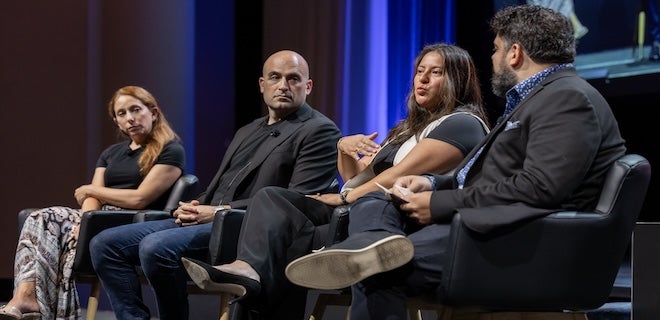
Programmatic IO, which took place September 29 and 30 in New York City, had plenty of takeaways for the publisher community. And there was lots of real talk about the monetization challenges publishers are facing today.
For instance, AdExchanger Senior Editor Anthony Vargas hosted a panel in which executives from The Independent, Recurrent and Forbes discussed ad ops’ favorite new toy, generative AI, and how publishers are using AI to their advantage.
We already know that AI search platforms are stealing traffic and scraping content without properly compensating publishers. However, as Rebeca Solórzano, SVP of Programmatic Operations and Strategy at Forbes, stated, the key to fighting AI’s traffic theft is to understand consumers’ needs and create diverse content and products that keep them coming back for more – and not only on your website.
“We’ve been focusing on video, newsletters, social media,” said Solórzano. “It’s all about understanding where users want to consume content.”
However, the real publisher tea was spilled in the super-secret publisher workshops co-hosted by AdMonsters and AdExchanger during the event. OK, these meetups weren’t as clandestine as I’m making them sound, but they were open to publishers only. That way, they could be an honest meeting of the minds, with publishers of all sizes and content types discussing the most significant issues they face, exploring possible solutions, and finding common ground.
With that promise of openness and honesty in mind, AdMonsters agreed to keep publishers’ identities secret in order to share some insights from these meetings.
Programmatic Revenue: Still the Weak Link
One of the most prominent themes in the publisher workshops was persistent frustration around programmatic revenue.
Despite heavy investment in programmatic tools and strategies, many publishers reported that the returns were underwhelming, especially for mid-sized news publishers.
As one ops director put it, “Programmatic was supposed to be a predictable revenue engine, but it feels like we’re spinning our wheels. We move traffic through dozens of platforms and see pennies on the dollar.”
Another publisher attendee added that managing programmatic feels like optimizing for someone else’s dashboard. The buy-side wins with increased ad performance, but publishers barely break even.
Some publishers noted that video and CTV inventory could provide relief because they attract higher prices than display inventory. But execution in these channels is complex.
“Scaling video is possible,” said a senior publisher, “but it’s resource-intensive, and without scale, the CPMs barely cover the cost of production.”
Life Beyond the Banner
Publishers are also thinking ahead to a future where traditional display may not be a core revenue driver.
“Display CPMs are flatlining, and the buy side is consolidating around fewer, larger deals,” one publisher noted. “We’re exploring CTV, native content, and even commerce integrations, anything that lets us connect directly with audiences instead of relying on resold impressions.”
As Forbes’ Solórzano mentioned during Prog IO’s publisher panel, it is important to build diversified products that go beyond banners. Some publishers mentioned they are starting to lean into newsletters and exclusive subscriber content in a similar fashion to Forbes.
At the end of the day, advertisers still want scale, but they also care about engagement and loyalty. Publishers understand that’s where the real value lies – and maximizing that value requires publishers and advertisers to rethink which metrics really matter.
“We can’t sell by impression anymore,” another attendee said. “It’s about time spent, interactions, and trust. Otherwise, campaigns underperform and relationships break down.”
Sales vs. Ops: The Eternal Tug-of-War
Another hot topic during Prog IO’s publisher workshops was the disconnect between sales teams and ad ops, an issue that continues to create operational headaches. Several workshop attendees said that overselling inventory is a common problem.
One publisher noted that sales teams would sometimes overpromise on impression volume, leaving ops teams scrambling to deliver campaigns when the actual site traffic falls short.
This misalignment hurts internal morale and impacts advertiser trust.
“Advertisers notice when campaigns underdeliver,” said another attendee. “It’s not just about numbers; it’s about credibility.”
The solution, according to multiple publishers, isn’t to try to place blame, but rather to engage in open communication with advertisers and set realistic goals. As one publisher put it, a site might not be able to deliver the impressions advertisers want exactly when they ask, but both parties can collaborate on a roadmap for how to reach that goal.
Ops teams are increasingly pushing for real-time reporting dashboards that feed directly into sales planning, so promises are realistic and campaigns are executable.
“If we can close the loop between what sales promises and what ops delivers,” one publisher said, “everyone wins.”